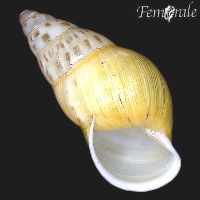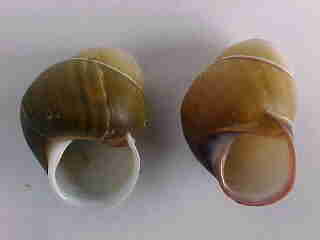
 Acavus sp. Aulopoma sphaeroideum
Aulopoda is endemic to Sri Lanka.
In the eastern part of this region there are a number of districts:Upper Burma,Pegu,
Tenasserim and Arakan.Some genera not found in India are present here.Sesara and Sophina
are members of the Helixarionidae family.Also living here is Hypselostoma,Rhaphaulus and
Pollicaria.The Helicinidae family is represented by Calybium and Pleuropoma.
Acavus sp. Aulopoma sphaeroideum
Aulopoda is endemic to Sri Lanka.
In the eastern part of this region there are a number of districts:Upper Burma,Pegu,
Tenasserim and Arakan.Some genera not found in India are present here.Sesara and Sophina
are members of the Helixarionidae family.Also living here is Hypselostoma,Rhaphaulus and
Pollicaria.The Helicinidae family is represented by Calybium and Pleuropoma.
The Siamese region includes Thailand,Cambodia,Laos and Vietnam.The Streptaxidae are very
well represented here with circa 30 species.Another family is the Camaenidae,about 36
species live in this region.Especially Amphidromus is a well known genus.
 Amphidromus furcilla(photo:Femorale)
The Bradybaenidae and Helixarionidae have also a large number of genera in this region.
More than 100 species of operculate snails are present here,for example Cyclophorus,Rhiostoma and Pterocyclos.
Amphidromus furcilla(photo:Femorale)
The Bradybaenidae and Helixarionidae have also a large number of genera in this region.
More than 100 species of operculate snails are present here,for example Cyclophorus,Rhiostoma and Pterocyclos.
The Malay region includes all the Sunda Islands,The Moluccas and of course Malaysia.
This is a huge area but has relatively few distinctive species.The Helixarionidae is
well represented here,with for example the genus Dyakia.Also Asperitas is a well
known genus.The Parmarioninae have their centre here.

 Asperitas polymorpha,photo:Korina Sangiouloglou. Parmarion martense
Asperitas polymorpha,photo:Korina Sangiouloglou. Parmarion martense
Amphidromus of the Camaenidae family is present here too,most of the species are sinistral.
Paraphaedusa of the Clausiliidae family has a few species living in this region.
More than 100 species of operculate snails live in Borneo alone.The Cochlostomatidae
is a very distinct family with the genus Ophisthostoma.
Crossopoma species are to be found in Borneo and Sumatra.


 Ophisthostoma tiesenhansemi Ophisthostoma linterae Crossopoma cornuvenatorium">
Ophisthostoma tiesenhansemi Ophisthostoma linterae Crossopoma cornuvenatorium">
The Philippine region has a very large number of species with a huge variety.The Helicostylinae,a subfamily of the Bradybaenidae,
has ten genera with depressed shells with a keel(Calocochlea),globose shells(Helicostyla)or elongated shells
(Chrysallis,Phengus and Canistrum).
The Camaenidae have quite a few species of the genus Obba,which are endemic.The shells are shaped like a lens,
brownish with white or yellow blotches,or with banding.
Again the family Helixarionidae has members here,two genera are Lepidotrichia and
Rhyssota.They have big shells measuring between 30 and 120 mm,and are caught for food
or bait.The subfamily Parmarioninae has two genera,Parmunculus and Philippinella which
mantle completely covers their reduced shells.
There are a huge number of operculate snails living in this region.For example Cyclo-
phorus,Cyclotus,Pupina.

 Helicostyla electrica Helicostyla florida
photo(c)Charles J. Geerts photo(c)Schoener specimen shells
Helicostyla electrica Helicostyla florida
photo(c)Charles J. Geerts photo(c)Schoener specimen shells